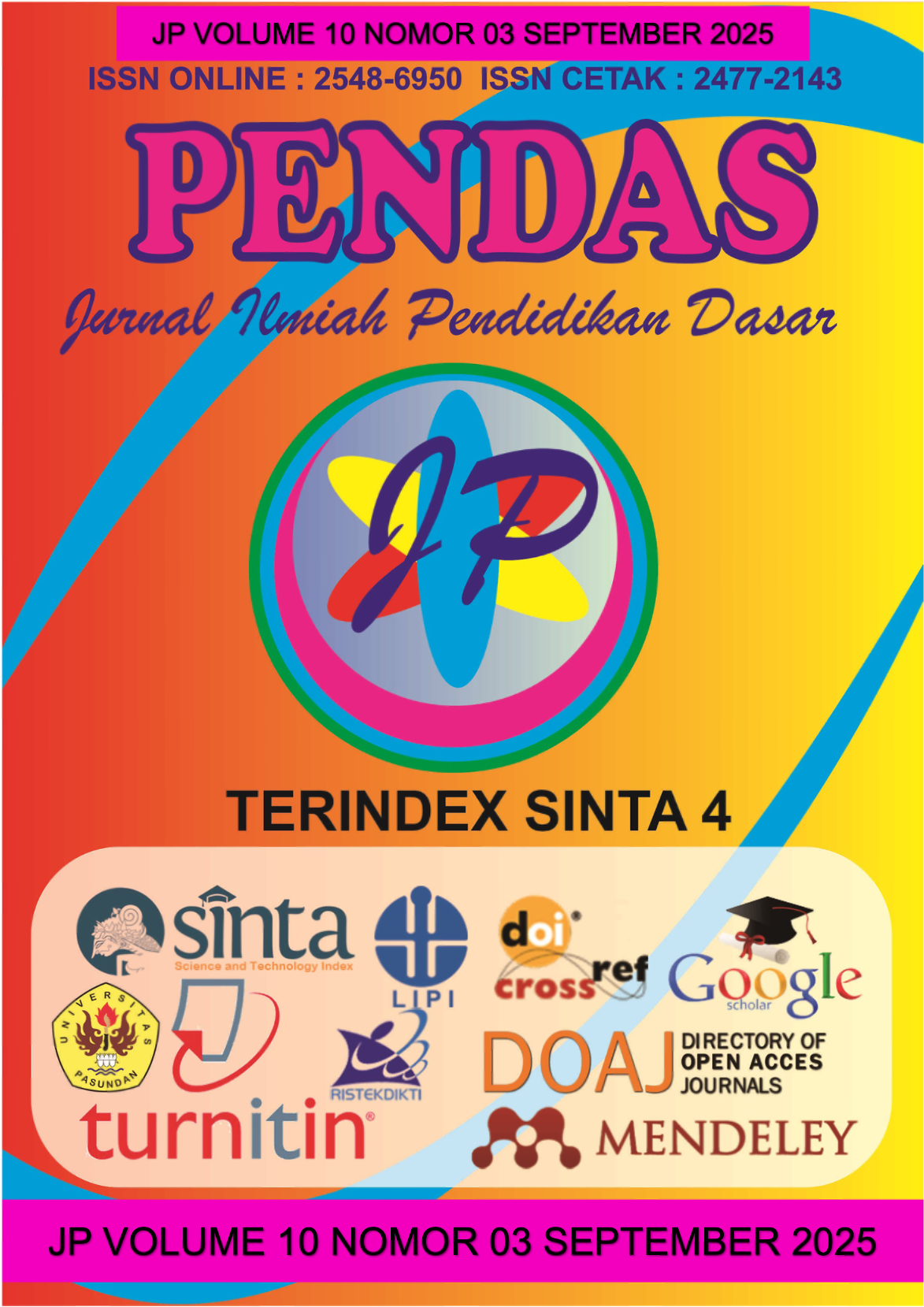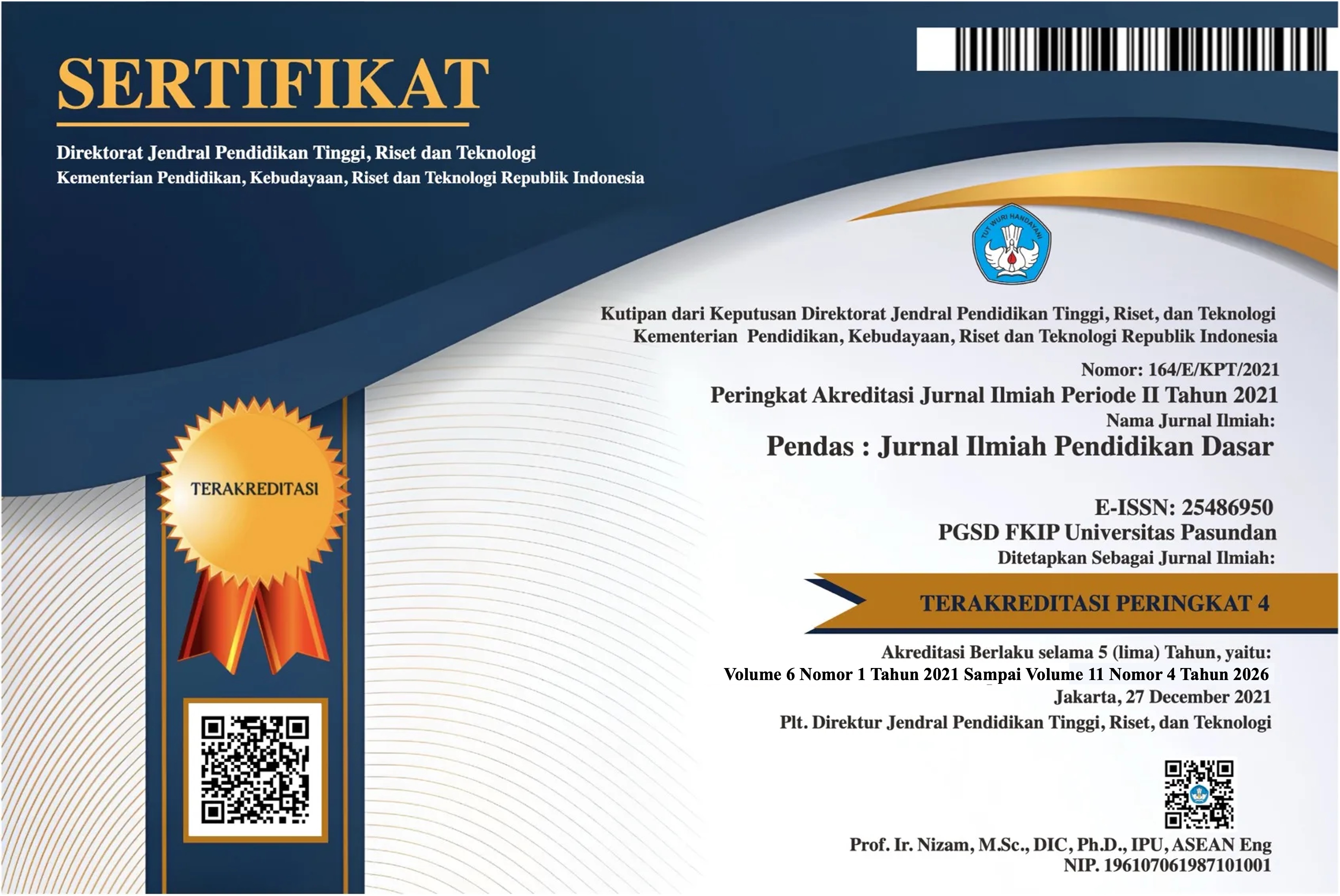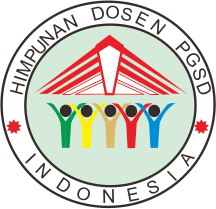SINESTESIA BAHASA MELAYU RIAU SUBDIALEK KECAMATAN PANGEAN
DOI:
https://doi.org/10.23969/jp.v10i03.32421Keywords:
Synesthesia, Malay, RiauAbstract
This study aims to describe the patterns and meanings of the synesthesia of the Riau Malay language Subdialect of Pangean District spoken by the people of Pangean District. The benefits of this research are (1) theoretically, this research is expected to expand the reader's knowledge about semantics, especially about the change in meaning regarding synesthesia (2) practically, the results of this research can be useful to find out various patterns of eating changes and their meanings, especially in the Riau Malay Subdialect of Pangean District. The data and data sources obtained in this study are in the form of community speech in Pangean District, especially in Pauh Angit Hulu village which contains synesthesia in daily communication. The data collection techniques in this study are listening, recording and recording techniques. The data in this study was analyzed using qualitative descriptive techniques. The method used is descriptive in the form of words and language. The data analysis technique in this study uses data reduction techniques, data presentation, conclusion drawing and data verification. Based on the results of the study, the pattern of synesthesia in the Riau Malay Subdialect of Pangean District consists of 8 patterns, namely, (1) the pattern of the sense of sight to the sense of hearing, (2) the pattern of the sense of taste to the sense of sight, (3) the pattern of the sense of taste to the sense of hearing, (4) the pattern of the sense of touch to the sense of hearing, (5) the pattern of the sense of smell to the sense of sight, (6) the pattern of the sense of smell to the sense of sight, (7) the pattern of the sense of touch to the sense of sight, (8) the pattern of the sense of hearing to the sense of sight. The meaning of synesthesia in the Riau Malay Subdialect of Pangean District was found to have a connotative meaning. Connotative meanings are found in 3 forms, namely, (1) positive connotative meaning, (2) negative connotative meaning, (3) neutral connotative meaning.
Downloads
References
Akhiruddin, Ashlah, L. N., Karman, A., Sehe, & Yusuf, A. B. (2024). Analisis Makna Konotasi pada Lirik Lagu “ Tenang ” Oleh Yura Yunita (Kajian Semantik). 4(2), 197–203.
Alhamid, T., & Anufia, B. (2019). RESUME: INSTRUMEN PENGUMPUL DATA. Sustainability (Switzerland), 11(1), 1–14. http://scioteca.caf.com/bitstream/handle/123456789/1091/RED2017-Eng-8ene.pdf?sequence=12&isAllowed=y%0Ahttp://dx.doi.org/10.1016/j.regsciurbeco.2008.06.
005%0Ahttps://www.researchgate.net/publication/305320484_SISTEM_PEMBETUNGAN_
TERPUSAT_STRATEGI_MELESTARI
Andini, C. D., Khairunnisa, F., Annisa, R., & Barus, F. L. (2021). Analisis Makna Konotatif dalam Novel Nanti Kita Cerita Tentang Hari ini Karya Marchella FP. Jurnal Serunai Bahasa Indonesia, 18(2), 43–49. https://doi.org/10.37755/jsbi.v18i2.385
Andriana, M., Auzar, A., & Charlina, C. (2020). Geram (Gerakan Aktif Menulis) Reduplikasi Bahasa Melayu Riau Dialek Kampar Kiri. 8, 27–36.
Antika, T. R., Ningsih, N., & Sastika, I. (2020). Analisis Makna Denotasi, Konotasi, Mitos Pada Lagu “Lathi” Karya Weird Genius. Asas: Jurnal Sastra, 9(2). https://doi.org/10.24114/ajs.v9i2.20582
Azwardi. (2018). Metode Penelitian Bahasa dan Sastra I ndonesia. Kuala University Press.
Chaer, A. (1990). Pengantar semantik bahasa indonesia. Rineka Cipta.
Chaer, A. (2009). Pengantar Semantik Bahasa Indonesia. PT Rineka Cipta.
Charlina, C., Nabila, N., Oktanur, O. D., Sari, T. Y., & Zaini, N. (2022). Analisis Campur Kode dan Alih Kode dalam Program Game Show TWK Season 2 pada Akun Youtube Narasi. Geram, 10(2), 71–77. https://doi.org/10.25299/geram.2022.vol10(2).11150
Fatoni, A. S. (2021). Fenomena Perluasan dan Penyempitan Makna dalam Ilmu Semantik. Lahjah Arabiyah: Jurnal Bahasa Arab dan Pendidikan Bahasa Arab, 2(1), 8–18. https://doi.org/10.35316/lahjah.v2i1.8-18
Firmansyah, R. B., Charlina, & Sinaga, M. (2024). Konotasi dalam Bahasa Komentator Sepakbola Valentino Simanjuntak pada Ajang AFF U19. 7.
Gusar, M. R. S., & Sianturi, M. F. (2023). Revitalisasi" Melek-Melekan" Sebagai Kearifan Lokal Batak Toba Yang Terabaikan. 4(1), 353–359.
Hanifah, D. U., Makruf, I., & Qosim, M. N. (2023). Pentingnya Memahami Makna, Jenis-jenis makna dan Perubahannya. Jurnal Ihtimam, 6(1), 157–171. https://doi.org/10.36668/jih.v6i1.483
Harti, T., Sinaga, M., & Hermandra, H. (2021). Penamaan Unsur Tumbuhan dan Hewan di Kepulauan Meranti (Kajian Semantik Inkuisitif). SASTRANESIA: Jurnal Program Studi Pendidikan Bahasa dan Sastra Indonesia, 9(1), 112. https://doi.org/10.32682/sastranesia.v9i1.1809
Kustriyono, E. (2016). perubahan makna dan faktor penyebab perubahan makan pada media cetak (Kajian Semantik Jurnalistik). 35, 4–13.
Mu’izzuddin, M. (2022). Analisis makna denotatif dan konotasi linguistik arab dalam istilah syariat islam. Journal of Education and Language Research, 8721(8.5.2017), 2003–2005.
Muzaiyanah. (2012). Jenis Makna dan Perubahan Makna. Wardah, 25, 145–152.
Nirindra, N., Charlina, & Burhanudin, D. (2021). Synesthesia in the novels of Kala work Rain Dreams dan Eleftheriaword Sinestesia dalam Novel Kala karya Hujan Mimpi dan Eleftheriaword. Jurnal Pendidikan Tambusai, 5(3), 7471–7476. https://jptam.org/index.php/jptam/article/view/2172
Nuari, P. (2016). Sinestesia dalam Bahasa Indonesia Laras Sastra. Sirok Bastra, 4(1). https://doi.org/10.37671/sb.v4i1.74
Nurhana, R. Y., Setyaningrum, W. F., & Puspidalia, Y. S. (2024). Sinestesia pada kumpulan Puisi Romantis Karya Sapardi Djoko Damono: Kajian Semantik. Pendidikan Bahasa dan Sastra Indonesia, 7, 14–27.
Nurpadillah, V. (2017). Wacana kepemimpinan: analisis makna konotasi dalam teks pidato perdana presiden Jokowi (Leadership work: Consumer Meaning Analysis in Primary Property Text Principle Jokowi). JalaBahasa, 13, 83–92.
Pateda, M. (2010). Semantik Leksikal (2nd ed.). Rineka Cipta.
Putri, D. A. (2018). Perancangan buku infografis mengenai sinesthesia Reimajenasi Timbre: Nostalgia Bunyi Melalui Komposisi Musik, 3, 1–15. http://digilib.isi.ac.id/id/eprint/8497
Saktika, G., & Nafisah, H. (2018). Sinestesia Inderawi pada indra Pengecapan.
Saputra, F., Sinaga, M., & Septyanti, E. (2024). Sinestesia Bahasa Melayu Riau Subdialek Kampar Kiri. MOTEKAR: Jurnal Multidisiplin Teknologi Dan Arsitektur, 2(1), 162–171. https://doi.org/10.57235/motekar.v2i1.2224
Sinaga, Y. C., Cyntia, S., Komariah, S., & Barus, F. L. (2021). Analisis Makna Denotasi dan Konotasi pada Lirik Lagu “Celengan Rindu” Karya Fiersa Besari. Jurnal Metabasa, 2(1), 38–50.
Sugiyono, S. (2016). Metode Penelitian Kuantitatif, Kualitatif, dan R&D (26th ed.). Alfabeta.
Suhardi, S. (2015). Dasar-Dasar Ilmu Semantik (Nurhid (ed.); 1st ed.). AR- RUZZ MEDIA.
Sumiati, Rachmi, M., & Didipu, H. (2021). Sinestesia dalam Novel Tajwid Cinta Hadwan Kafiya karya Lebah Ratih (Studi Kajian Semantik). Jambura Journal of Linguistics and Literature, 2(1), 15–28. https://ejurnal.ung.ac.id/index.php/jjll/article/view/10678
Supadi. (2020). Perkembangan Makna sebagai Ajang Semantik. Prosiding Seminar Daring Nasional: Pengembangan Kurikulum Merdeka Belajar Program Studi Pendidikan Bahasa Indonesia, 76–83.
Sutriani, E., & Octaviani, R. (2019). Topik: Analisis Data dan Pengecekan Keabsahan Data. INA-Rxiv, 1–22.
Suwatno, E. (2016). Metafora Sinestesia dalam Bahasa Jawa. Jalabahasa, 12(2), 101–109.
TUDJUKA, N. S. (2019). Makna denotasi dan konotasi pada ungkapan tradisional dalam konteks pernikhan adat suku pamona. Jurnal Bahasa Dan Sastra, 4(1), 12–25.
Virgiawan, A. (2024). Sinestesia dalam Novel Bumi dan Bulan Karya Tere Liye Serta Implikasinya terhadap Pembelajaran Bahasa Indonesia.
Yuliana, R. (2015). Sinestesia indrawi pada novel rindu karya Tere Liye : Kajian Semantik.
Zellatifanny, C. M., & Mudjiyanto, B. (2018). Tipe Penelitian Deskripsi Dalam Ilmu Komunikasi. Diakom : Jurnal Media dan Komunikasi, 1(2), 83–90. https://doi.org/10.17933/diakom.v1i2.20
Downloads
Published
Issue
Section
License
Copyright (c) 2025 Pendas : Jurnal Ilmiah Pendidikan Dasar

This work is licensed under a Creative Commons Attribution 4.0 International License.



















